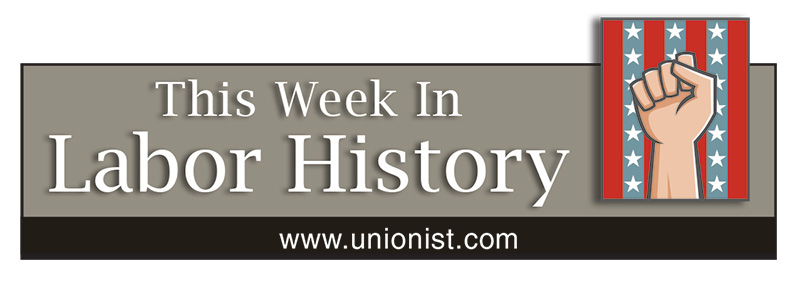This week in labor history: May 4-10

MAY 4
1886 – Haymarket massacre – a bomb is thrown as Chicago police start to break up a rally for strikers at the McCormick Harvesting Machine Co. A riot erupts, 11 police and strikers die, mostly from gunfire, and scores more are injured.
MAY 5
1852 – National Typographical Union founded, Cincinnati, Ohio. It was renamed the Int’l Typographical Union in 1869, in acknowledgment of Canadian members. When the ITU merged into CWA in 1986 it was the oldest existing union in the U.S.
1886 – On Chicago’s West Side, police attack Jewish workers as they try to march into the Loop to protest slum conditions.
1886 – Some 14,000 building trades workers and laborers, demanding an eight-hour workday, gather at the Milwaukee Iron Co. rolling mill in Bay View, Wisc. When they approach the mill they are fired on by 250 National Guardsmen under orders from the governor to shoot to kill. Seven die, including a 13-year-old boy.
1888 – Nineteen machinists working for the East Tennessee, Virginia, and Georgia Railroad gather in a locomotive pit to decide what to do about a wage cut. They vote to form a union, which later became the Int’l Association of Machinists.
1920 – Italian-American anarchists Nicola Sacco and Bartolomeo Vanzetti are arrested in Boston for murder and payroll robbery. Eventually they are executed for a crime most believe they did not commit.
1931 – Heavily armed deputies and other mine owner hirelings attack striking miners in Harlan County, Ky., starting the Battle of Harlan County.
1934 – John J. Sweeney, president of the Service Employees Int’l Union from 1980 to 1995, then president of the AFL-CIO from 1995 to 2009, born in the Bronx, N.Y.
1937 – Lumber strike begins in Pacific Northwest, will involve 40,000 workers by the time victory is achieved after 13 weeks with union recognition, a 50-cents-per-hour minimum wage and an eight-hour day.
2000 – The U.S. unemployment rate drops to a 30-year low of 3.9 percent; the rate for blacks and Hispanics is the lowest ever since the government started tracking such data.
2018 – Capping several weeks of teacher unrest across the country, public educators in Arizona win raises of 10 to 20 percent following a week-long strike; Oklahoma teachers shortly before that struck for nine days and won roughly $6,000 in annual increases, while the teachers who started it all, in West Virginia, won a five percent raise after their nearly two-week walkout.
MAY 6
1935 – Works Progress Administration (WPA) established at a cost of $4.8 billion — more than $80 billion in 2015 dollars — to provide work opportunities for millions during the Great Depression.
1937 – Four hundred black women working as tobacco stemmers walk off the job in a spontaneous revolt against poor working conditions and a $3 weekly wage at the Vaughan Co. in Richmond, Va.
MAY 7
1867 – The Knights of St. Crispin union is formed at a secret meeting in Milwaukee. It grew to 50,000 members before being crushed by employers later that year.
1907 – Two die, 20 are injured in “Bloody Tuesday” as strikebreakers attempt to run San Francisco streetcars during a strike by operators. The strike was declared lost in 1908 after many more deaths, including several in scab-operated streetcar accidents.
1977 – Philadelphia’s longest transit strike ends after 44 days. A key issue in the fight was the hiring and use of part-timers.
MAY 8
1970 – About 200 construction workers in New York City attack a crowd of Vietnam war protesters four days after the Kent State killings. More than 70 people were injured, including four police officers. Peter Brennan, head of the New York building trades, was honored at the Nixon White House two weeks later, eventually named Secretary of Labor.
1997 – Some 12,000 Steelworker-represented workers at Goodyear Tire & Rubber win an 18-day strike for improved wages and job security.
MAY 9
1837 – The first Anti-Slavery Convention of American Women is held on this date in New York City. Attendees included women of color, the wives and daughters of slaveholders, and women of low economic status.
1909 – Japanese workers strike at Oahu, Hawaii’s Aiea Plantation, demanding the same pay as Portuguese and Puerto Rican workers. Ultimately 7,000 workers and their families remained out until August, when the strike was broken.
1907 – Legendary Western Federation of Miners leader William “Big Bill” Haywood goes on trial for murder in the bombing death of former Idaho governor Frank Steunenberg, who had brutally suppressed the state’s miners. Haywood ultimately was declared innocent.
1937 – Hollywood studio mogul Louis B. Mayer recognizes the Screen Actors Guild. SAG leaders reportedly were bluffing when they told Mayer that 99 percent of all actors would walk out the next morning unless he dealt with the union. Some 5,000 actors attended a victory gathering the following day at Hollywood Legion Stadium; a day later, SAG membership increased 400 percent.
1971 – United Auto Workers President Walter Reuther and his wife May die in a plane crash as they travel to oversee construction of the union’s education and training facility at Black Lake, Mich.
1972 – Four thousand garment workers, mostly Hispanic, strike for union recognition at the Farah Manufacturing Co. in El Paso, Texas.
MAY 10
1869 – Thanks to an army of thousands of Chinese and Irish immigrants, who laid 2,000 miles of track, the nation’s first transcontinental railway line was finished by the joining of the Union Pacific and Central Pacific lines at Promontory Point, Utah.
1898 – U.S. & Canadian workers form Western Labor Union. It favors industrial organization and independent Labor party politics.
2005 – A federal bankruptcy judge permits United Airlines to legally abandon responsibility for pensions covering 120,000 employees.
(Compiled by David Prosten, founder Union Communication Services)


Leave a Reply